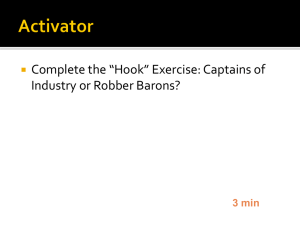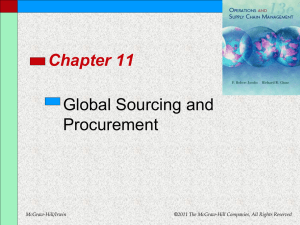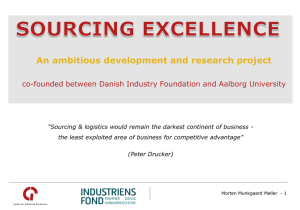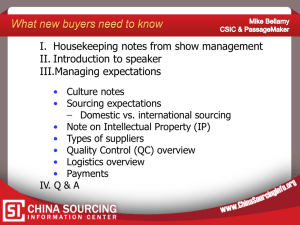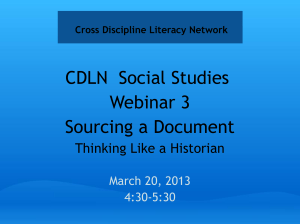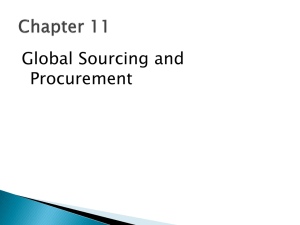GU-GlobalSourcing-BP-October6-2010
advertisement
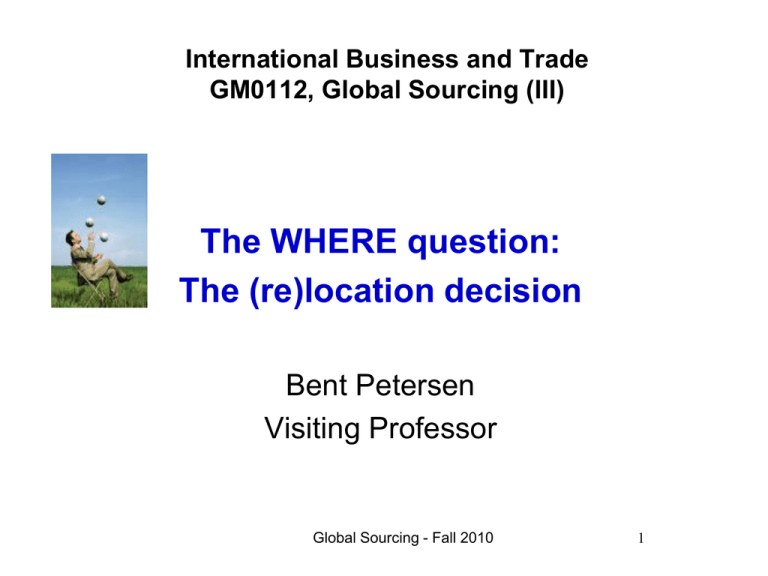
International Business and Trade GM0112, Global Sourcing (III) The WHERE question: The (re)location decision Bent Petersen Visiting Professor Global Sourcing - Fall 2010 1 Contents of today’s lecture 1. Modeling the location decision 2. A disaggregated and dynamic approach to localization 3. The “Smile curve” 4. Case example: The GPN of Dell computer Global Sourcing - Fall 2010 2 The WHERE question Where to (re)locate underperforming, or underdeveloped), domestic value chain activities? Literature streams/theory: Economic geography (including agglomeration economies), institutional theory, global SCM/logistics literature. In the case of offshore outsourcing the WHERE question is closely related to the question of partner selection (“the WHO question”) . Global Sourcing - Fall 2010 3 The choice of location and partner selection following an offshore outsourcing decision (Graf & Mudambi, 2005) Global Sourcing - Fall 2010 4 Modeling the offshore out-sourcing location decision (Graf & Mudambi, 2005) Global Sourcing - Fall 2010 5 A value chain approach to location The location decision should be taken for individual value chain activities (‘tasks’) – not for the value chain as a whole. As an example, the optimal location of manufacturing would usually differ from R&D location (unless co-location synergies are vital). What about “top management”, logistics, etc.? Global Sourcing - Fall 2010 6 A dynamic approach to location Comparative advantages are proprietary to countries, not to single firms, and they tend to dry out (Porter 1990). Therefore… …either MNCs should re-locate their value chain activities persistently according to geographically changing comparative advantages (thereby becoming “footloose MNCs”), or … MNCs should locate their value chain activities according to comparative advantages that over a period of time may transcend into competitive advantages, i.e. firm-specific advantages through competence creation. Global Sourcing - Fall 2010 7 The “Smile curve” The smile curve of value creation (or rather, value appropriation?) conjectures a division of labor between developed market firms and firms from emerging market economies. Developed market firms are concentrating on upand down-stream high value-added activities and relocating /outsourcing low value-added activities to emerging economies firms. Global Sourcing - Fall 2010 8 The smile of value creation (Mudambi, 2007) Mudambi, R. J Econ Geogr 2008 8:699-725; doi:10.1093/jeg/lbn024 Global Sourcing - Fall 2010 Copyright restrictions may apply. 9 Value chain configuration in the Danish apparel industry: Three business models Global Sourcing - Fall 2010 10 shoes: Location of employees Composition of employees in ECCO by geography 10000 . 8000 6000 4000 2000 0 1980 1982 1984 1986 1988 Employees in Denmark 1990 1992 1994 1996 1998 Employees outside Denmark 2000 2002 2004 Evidence of value chain configuration of Danish MNCs Type of activities carried out in Denmark and abroad 60 50 40 30 20 10 0 D R& an Lo d Carried out in Denmark primarily to serve the local market Carried out in Denmark primarily to serve the company and all its markets Carried out abroad primarily to serve the local market de t gis sig ics n d an r pu a ch g sin o Pr du cti on o o fg o Pr s od du o cti n of rv e s S s ice s ale a nd in et g k ar m str i in dm ion t a cl (in A - Fall 2010 Global Sourcing in ud g ) IT Carried out abroad primarily to serve the company and all its markets 12 Evidence of value chain configuration of Danish MNCs (cont’d) Character of flows between company units in different countries 60 50 40 30 20 10 0 Goods Services Knowledge Money/Capital Mainly from Fairly balanced Denmark to foreign countries Mainly from foreign countries to Denmark Global Sourcing - Fall 2010 13 The smile curve in transition 3 forces are eroding the traditional DoL pattern: The catch-up effect of emerging economies firms. Standardization and commodization of high added-value activities such as R&D. Move of entire ‘sunset’ industries to emerging economies. Global Sourcing - Fall 2010 14 The smile. Dynamic analysis Mudambi, R. J Econ Geogr 2008 8:699-725; doi:10.1093/jeg/lbn024 Global Sourcing - Fall 2010 Copyright restrictions may apply. 15 The smile curve of Apple’s i-Phone Apple’s outsorcing pattern conforms to the “smile of value creation/appropriation” The miles of value creation may be a nested one inside the other, like ‘Russian dolls’. Please note that Mudambi (2008) uses “dispersed value chains” in a purely geographic sense, and not in relation to DoL. Global Sourcing - Fall 2010 16 Value creation in the iPhone Mudambi, R. J Econ Geogr 2008 8:699-725; doi:10.1093/jeg/lbn024 Global Sourcing - Fall 2010 Copyright restrictions may apply. 17 A world map of services offshoring Global Sourcing - Fall 2010 Source: McKinsey Global18 Institute, 2005 The global production network (GPN) of Dell Computer Global Sourcing - Fall 2010 19 The GPN of Dell Dell’s nested hierarchy of location factors: 1. Market access 2. Labor costs and quality 3. Transportation and telecommunication infrastructure 4. Government incentives 5. Industry clusters (question of partner selection). Global Sourcing - Fall 2010 20 The GPN of Dell (2) However, Dell’s nested hierarchy relates primarily to manufacturing (assembling activities)… …and differs with value chain functions (such as sourcing, M&S, customer services) and subsumed activities (e.g. call centers servicing different customer groups). Examples: European data center in Bracknell, UK (not in low-cost Ireland) due to better infrastructure. Sales offices very scattered. Global Sourcing - Fall 2010 21 The GPN of Dell (2) Two thirds of Dell’s employees are still employed in USA (2002). Regional orientation. Extreme pressure on suppliers (e.g. demands of JIT, annual price lowering). Core competencies of Dell: Assembling activities are kept in-house. Sweden considered “English speaking market” (p. 15)! Global Sourcing - Fall 2010 22 Next lecture: The HOW question How to organize global sourcing? What should be the ownership structure of activities (re-) located abroad? Captive? Outsourced? JV? Theory/literature streams: Organizational economics (including TCEs and agency theory), organizational learning literature. End of lecture 6 October, 2010 - Thank you for your attention! Global Sourcing - Fall 2010 23
